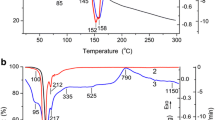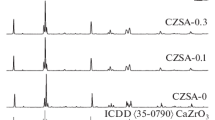Abstract—
We have studied the process and products of thermal dehydration of highly dispersed monoclinic AlРO4⋅2Н2О prepared by crystallization from an aluminum phosphate solution at 95–97°C and demonstrated the influence of isothermal or polythermal heat treatment on the formation of AlPO4 polymorphs similar in structure to α-quartz or tridymite. The formation of these phases has been shown to be related to changes in the oxygen coordination of aluminum as a result of the detachment of highly polarized molecules of water of crystallization in the composition of AlРO4⋅2Н2О. We have assessed the electrorheological (ER) activity of AlPO4 as a disperse phase of electrorheological fluids, with a weight fraction from 10 to 20%, and found out how AlPO4 preparation conditions influence the shear stress of the electrorheological fluids in electric fields from 3.5 to 4.0 kV/mm. Suspensions containing tridymite AlPO4 particles prepared under isothermal conditions have been shown to exhibit a stronger ER effect, at a level from 420 to 620 Pa. The ER activity of AlPO4 has been shown to increase with increasing heat treatment temperature and time, which is attributable to the formation of a more defect-rich particle surface due to intrinsic thermal disorder.




Similar content being viewed by others
REFERENCES
Hao, T., Electrorheological Fluids: The Non-Aqueous Suspensions, Studies in Interface Science, vol. 22, Amsterdam: Elsevier, 2005.
Hwang, Y.H. et al., An electrorheological spherical joint actuator for a haptic master with application to robot-assisted cutting surgery, Sens. Actuators, A, 2016, vol. 249, pp. 163–171. https://doi.org/10.1016/j.sna.2016.08.033
Wang, L., Gong, X., and Wen, W., Electrorheological fluid and its applications in microfluidics, Top. Curr. Chem., 2011, vol. 304, pp. 91–115. https://doi.org/10.1007/128_2011_148
Chiolerio, A. and Quadrelli, M.B., Smart fluid systems: the advent of autonomous liquid robotics, Adv. Sci., 2017, vol. 4, no. 7, p. 1700036. https://doi.org/10.1002/advs.201700036
Hines, L. et al., Soft actuators for small-scale robotics, Adv. Mater., 2017, vol. 29, p. 1603483. https://doi.org/10.1002/adma.201603483
Hong, J.Y., et al., Geometrical study of electrorheological activity with shape-controlled titania-coated silica nanomaterials, J. Colloid Interface Sci., 2010, vol. 347, no. 2, pp. 177–182. https://doi.org/10.1016/j.jcis.2010.03.054
Block, H. and Kelly, J.P., Electro-rheology, J. Phys. D: Appl. Phys., 1988, vol. 21, pp. 1661–1677.
Eshchenko, L.S., Laevskaya, E.V., Korobko, E.V., and Novikova, Z.A., Preparation of fillers for hydrous aluminum orthophosphate-based ERFs, Tr. BGTU, Ser. Khim., 2015, no. 3, pp. 56–63.
Lapko, K.N., Makatun, V.N., and Ugolev, I.I., Proton structure of crystalline aluminum dihydrogen tripolyphosphate dihydrate, Zh. Neorg. Khim., 1980, vol. 25, no. 6, pp. 1688–1691.
Laevskaya, E.V., Eshchenko, L.S., Korobko, E.V., Novikova, Z.A., and Unal, Kh.I., Effect of the structure of aluminum orthophosphate dihydrate on its electrorheological activity, in Teplo- i massoperenos-2014: sbornik nauchnykh trudov (Heat and Mass Transport-2014: Collection of Scientific Works), Minsk: Inst. Teplo- i Massoperenosa imeni A.V. Lykova Nats. Akad. Nauk Belarusi, 2015, pp. 263–270.
Eshchenko, L.S. and Paniatouski, A.V., Distinctive features of the synthesis of highly dispersed aluminophosphates with the composition AlPO4·nH2O, Vestsi Nats. Akad. Navuk Belarusi, Ser. Khim. Navuk, 2021, vol. 57, no. 3. pp. 310–319. https://doi.org/10.29235/1561-8331-2021-57-3-310-319
Kotova, N.P. and Ivanov, L.P., Stability of strontium aluminophosphates in the system SrO–Al2O3–P2O5–H2O at T = 25–350°C and P = P sat–500 bar, Geochem. Int., 2000, vol. 38, pp. 138–143.
D’Yvoire, F., Etude des phosphates d’aluminium et de fer trivalent. I. L’orthophosphate neutre d’aluminium, Bull. Soc. Chim. Fr., 1961, pp. 1762–1776.
Melikhov, I.V., Fiziko-khimicheskaya evolyutsiya tverdogo veshchestva (Physicochemical Evolution of Solids), Moscow: BINOM. Laboratoriya Znanii, 2006.
Yaroslavtsev, A.B., Khimiya tverdogo tela (Solid State Chemistry), Moscow: Nauchnyi Mir, 2009.
Author information
Authors and Affiliations
Corresponding author
Ethics declarations
The authors declare that they have no conflicts of interest.
Additional information
Translated by O. Tsarev
Rights and permissions
About this article
Cite this article
Eshchenko, L.S., Korobko, E.V. & Paniatouski, A.V. Preparation and Electrorheological Properties of Anhydrous Aluminum Orthophosphate. Inorg Mater 59, 75–80 (2023). https://doi.org/10.1134/S0020168523010077
Received:
Revised:
Accepted:
Published:
Issue Date:
DOI: https://doi.org/10.1134/S0020168523010077




